Did you know that every single minute, 500 hours of video are uploaded to YouTube?
Yes, you read that right. That’s a LOT of content. So, with all that noise and competition, just having great content isn’t enough anymore; you also have to nail the timing.
You might be thinking, “But wait, doesn’t the almighty algorithm handle all that?”
And you’d be partially correct! While YouTube’s recommendation engine is a beast, posting at an optimal time with a YouTube scheduler gives your content that initial burst of momentum.
This early engagement is a massive signal that tells the algorithm, “Hey, pay attention to this video, users are loving it!”
We analyzed the freshest engagement data from over 1 million posts (part of a massive 2 million video and Shorts dataset) to bring you a truly data-driven strategy.
In this ultimate guide, we’ll break down the best time to post on YouTube so you know exactly when to hit ‘Publish.’
Let’s get started!
Short Summary
- The best time to post on YouTube is typically between 3 p.m. and 5 p.m. on weekdays, with Wednesday at 4 p.m. being optimal.
- Mondays and Thursdays also perform well, particularly in the afternoon, with engagement peaking around 4 p.m.
- Weekends, especially Saturdays, tend to have lower engagement than weekdays, making them less ideal for posting.
- YouTube Shorts also thrives around 4 p.m., with Wednesday, Thursday, and Monday standing out as top days for posting.
- Use YouTube’s Native Analytics or Social Champ to track your specific audience’s behavior and fine-tune your posting schedule.

Tired of Guessing the Best Time to Post on YouTube?
Social Champ takes the guesswork out of timing by providing you with precise scheduling tools to post at the best times for engagement.
Featured Article: A Complete Guide on How to Schedule YouTube Videos
What Is the Best Time to Post YouTube Videos in 2026: Global Insights
If you’re wondering whether timing really makes a difference on YouTube, the answer is a firm yes—and there’s data to back it up.
Thanks to our analytics tool and multiple studies from sources like HubSpot, consistently show that when you post can have a significant impact on how well your video performs.
Let’s take a look!
Peak Engagement Falls Between Late Afternoon and Early Evening
Across multiple studies, one pattern consistently stands out: afternoons and early evenings tend to generate the highest viewer activity on YouTube.
Specifically, the 3 PM to 5 PM window on weekdays has emerged as a sweet spot.
This time frame allows your video to populate in feeds and recommendations just before users log on after school, work, or during evening downtime.
Think of it as positioning your video just ahead of the evening rush, giving YouTube time to index and distribute your content before viewers start actively browsing.
The Golden Hour: Wednesday at 4 PM
Among all time slots analyzed, Wednesday at 4 PM appears to outperform others regarding average views.According to research, videos posted at this time consistently see higher engagement.
Friday and Thursday, followed by Monday at 4 P.M., also rank well, but Wednesday stands out as the prime opportunity for visibility.
Why mid-week? Likely because audiences are settled into their weekly routine by then and are more receptive to consuming new content, especially before the content-heavy weekend.
Late-Night Activity Also Holds Value
While afternoon posts get a head start, evening hours (6 PM to 9 PM) remain strong contenders for engagement.
HubSpot’s findings suggest that many users scroll through YouTube during their evening wind-down, often from mobile devices or smart TVs.
That makes sense: this is when people are relaxing and unwinding and more willing to click on long-form content or explore something new.
If your audience is older or international, these late slots might work even better.
At a glance:
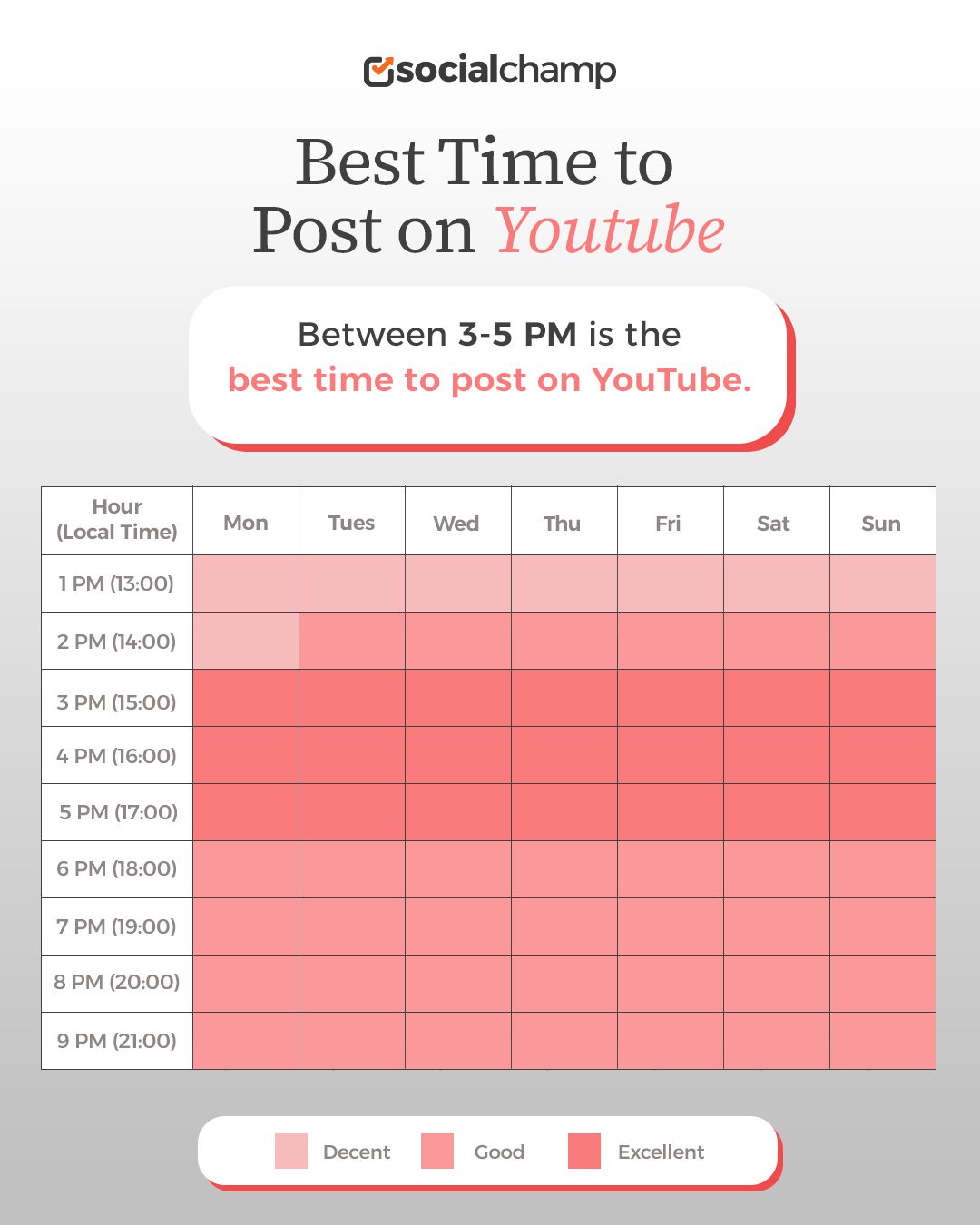
Which Days and Hour Get the Most YouTube Views?
While the general advice is to post on YouTube in the afternoon to early evening, viewer behavior actually shifts slightly depending on the day of the week.
Understanding these patterns can help you time your uploads for when your audience is naturally more active, without relying on guesswork.
Based on aggregated data from various platforms and scheduling tools, here’s how engagement typically flows throughout each day.
At a glance:
| Best Day to Post on YouTube | Best Time To Post YouTube Videos | Target Viewers |
|---|---|---|
| Monday | 12:00 p.m. – 4:00 p.m. | Good time to catch early-week viewers settling into routine. |
| Tuesday | 12:00 p.m. – 3:00 p.m. | Moderate activity; afternoons offer better chances for visibility. |
| Wednesday | 2:00 p.m. – 5:00 p.m. | Engagement increases midweek, a strong window for building momentum. |
| Thursday | 3:00 p.m. – 5:00 p.m. (7:00 p.m. optional) | User activity starts to ramp up; evening posting also sees good traction. |
| Friday | 3:00 p.m. – 5:00 p.m. | A great slot to tap into end-of-week viewership. |
| Saturday | 3:00 p.m. – 5:00 p.m. | Weekend viewers are more relaxed; ideal for long-form or casual content. |
| Sunday | 12:00 p.m. – 4:00 p.m. | Best to post early in the day, before people shift focus to the new week |
Best Time to Post on YouTube Monday
Afternoon slots between 12 p.m. and 4 p.m. often see steady engagement.
As people settle into the week, they tend to check in on content during lunch breaks or after work, making mid-afternoon a useful time to catch returning viewers and casual browsers alike.
Best Time to Post on YouTube Tuesday
Viewership continues to build slightly as the week progresses.
Posting between 12 p.m. and 3 p.m. can work well to align with lunchtime scrolling and early post-work relaxation.
The mid-afternoon window offers a nice balance between catching users on a break and allowing time for the algorithm to distribute the video.
Best Time to Post on YouTube Wednesday
Wednesday at 4 p.m. has consistently been flagged as one of the best times to post on YouTube.
It’s the midweek moment when engagement surges, possibly because viewers seek a mental break from their work or school routine.
Posting on Wednesdays between 2 p.m. and 5 p.m. is smart if you’re aiming for strong, early engagement and steady momentum.
Best Time to Post on YouTube Thursday
The rhythm of the week usually sees a boost around Thursday.
Uploads scheduled from 3 p.m. to 5 p.m. often perform well, capitalizing on growing user activity as people begin to unwind and plan their leisure time.
Some data also shows evening hours (around 7 p.m.) bringing in additional engagement.
Best Time to Post on YouTube Friday
On Fridays, user activity tends to peak in the afternoon to early evening.
Posting from 3 p.m. to 5 p.m. aligns well with when many users start to transition out of their workweek mindset.
This gives your content room to breathe and potentially carry performance into the weekend.
Best Time to Post on YouTube Saturday
Weekends bring a shift in viewing habits.
On Saturdays, people are more likely to engage with content throughout the early to mid-afternoon window—generally from 3 p.m. to 5 p.m.
This flexibility makes it a good day to experiment with slightly longer content or series-style uploads.
Best Time to Post on YouTube Sunday
Sundays often follow a similar pattern to Saturdays, but with a lean toward earlier afternoon slots, typically between 12 p.m. and 4 p.m.
As the day progresses, viewers begin to wind down and shift focus to the upcoming week, so posting earlier can help your content stay visible during their active hours.
If you want to know about the best time to post on other platforms like Facebook, Instagram, TikTok, LinkedIn, and Twitter, refer to the following articles:
Why Weekdays Dominate YouTube Engagement
Our data shows that the period from Wednesday through Friday consistently outperforms the weekend for peak engagement hours.
While Saturdays and Sundays still see high overall traffic, the intense viewing bursts that give a video its best initial momentum happen when users are settled into their weekly routine.
Why Weekdays Win: The Audience Routine
This pattern isn’t random; it reflects major shifts in how people consume media throughout their week.
Unlike TV, which dominates weekend prime time, YouTube consumption is heavily tied to daily transitional moments and downtime:
- The Work/School Break: The 3 PM to 5 PM rush, which contains the “Golden Hour,” directly corresponds to the end of the school day and mid-afternoon work breaks. People use this time to catch up on subscriptions or quickly check out trending Shorts.
- The Commute Consumption: For many, the evening commute is dedicated screen time. Whether on a train, bus, or waiting in the car, this window allows viewers to dive into longer-form content they might have saved from the day.
- Evening Relaxation: Post-dinner, before bed, is when many viewers switch on their mobile devices or smart TVs for a dedicated wind-down session. This is the prime time for in-depth tutorials, vlogs, and entertainment content. Weeknights offer a more predictable block of relaxation time compared to the varied schedule of a weekend.
How Do Video Type and Industry Influence the Best Time to Upload on YouTube?
If you want to master your YouTube schedule truly, you have to stop treating all content the same.
What works for a detailed cooking tutorial likely won’t work for a viral gaming Short. The best time to upload depends heavily on what you post and who you’re posting for.
Long-Form Videos vs. YouTube Shorts: Two Separate Strategies
The fundamental difference between long-form content (videos over 1 minute) and Shorts (vertical videos up to 60 seconds) lies in how and when they are consumed:
- Long-Form Videos (The Deep Dive): These require dedicated watch time; viewers need to sit down and be ready to commit 5, 10, or 20+ minutes. They perform best when viewers are settling in for the night.
- Optimal Time: Late Afternoons and Early Evenings (especially 3 PM – 6 PM and 6 PM – 9 PM on weekdays). This captures the post-work/post-school relaxation crowd.
- YouTube Shorts (The Quick Fix): Shorts thrive on quick, immediate attention and are often watched in rapid succession (doom-scrolling). They are perfect for filling short gaps in the day.
- Optimal Time: Mid-Day Breaks (especially 12 PM – 1 PM) and the Mid-Afternoon (around 4 PM). This targets viewers checking their phones during lunch, waiting in line, or taking a quick break.
This difference is so crucial that you should seriously consider maintaining separate schedules for your long videos and your Shorts to maximize the initial burst for both!
Industry Breakdown: Nailing Your Niche’s Timing
Your audience’s life schedule determines your peak time. A business professional, a high school gamer, and a home cook all follow vastly different rhythms.
Here is a breakdown of when different niches see their highest engagement:
| Industry Niche | Best Days to Post on YouTube | Optimal Time Window (Local Time) | Why It Works |
|---|---|---|---|
| Gaming & Entertainment | Thursday, Friday, Saturday | 7 PM – 11 PM | Gamers and entertainment seekers are most active after work/school and late into the night. |
| Education & Tutorials | Monday, Tuesday, Wednesday | 10 AM – 2 PM | Many viewers watch instructional content during the workday, using it for research or skill development. |
| Fitness & Health | Monday, Sunday | 9 AM – 1 PM | Motivation peaks at the start of the week (Monday) and during weekend downtime (Sunday) for planning. |
| Beauty & Fashion | Wednesday, Friday | 3 PM – 5 PM | Captures the “wind-down” moment when people are catching up on style trends and engaging with visual content. |
| Technology & Science | Tuesday, Thursday | 1 PM – 4 PM | Appeals to a business/professional audience that is online during core working hours for industry news. |
| Food & Cooking | Wednesday, Saturday | 4 PM – 7 PM | Perfect timing to inspire viewers with dinner ideas just before they start cooking or planning their weekend meals. |
Your Next Step: Test and Track
Use the table above to create an experimental schedule, but always remember to test both formats!
Post your long videos at 7 PM on Thursday and your Shorts at 4 PM on Tuesday. Then, dive into your YouTube Analytics to see when your specific audience is watching.
That is the only way to find your true personal golden hour.
What Is the Best Time to Post on YouTube by Country and Time Zones?
Based on competitor findings and general platform trends, the table below provides optimal posting time frames (local time) for broad regions.
But remember: Always prioritize your own channel’s YouTube Analytics data over these general times.
| Region/Country | Optimal Posting Window (Weekdays – Local Time) | Optimal Posting Window (Weekends – Local Time) | Viewership Trend |
|---|---|---|---|
| North America (U.S./Canada) | 12 PM – 5 PM (EST/PST) | 9 AM – 2 PM (EST/PST) | Strong mid-day and late-afternoon peaks for breaks and leisure. |
| UK/Europe | 4 PM – 7 PM (GMT/CET) | 11 AM – 2 PM (GMT/CET) | Afternoon/Early evening for after-work/school relaxation. |
| South Asia (India) | 8 PM IST | 11 AM IST | High evening viewership after daily routines; late mornings on weekends. |
| Australia | 6 PM – 8 PM (AEST) | 1 PM – 4 PM (AEST) | Evening is prime time after work, with weekend afternoons also strong. |
Aligning with Your Audience and Scheduling
The biggest piece of advice is to align your posting times with your audience’s primary location using YouTube Studio Analytics.
- Access Audience Data: Go to YouTube Studio Analytics, Audience “When your viewers are on YouTube.” This heatmap shows exactly when your viewers are most active, displayed in their local time.
- Prioritize Your Top Region: If 80% of your audience is in the U.S., schedule your post for their peak time. If you have a global audience, target the peak time of your largest audience segment.
- Cross-Time Zone Scheduling: For channels with significant audiences across multiple time zones (e.g., U.S. and U.K.), publishing 2-3 hours before the peak time in your largest region can allow the video to gain initial traction, or use a tool like Social Champ that can automatically handle scheduling across multiple time zones to hit different local peaks with separate posts (if using other platforms like Twitter or Facebook to promote the video).

Still Guessing When to Post?
Stop wasting time. Social Champ tells you exactly when your audience is most active, so you never miss the right moment.
Best Time to Post YouTube Shorts for Maximum Reach
If you’re creating YouTube Shorts, when you post can make a noticeable difference in how many people see your content.
Shorts are designed for quick, casual viewing—perfect for catching users during short breaks or downtime.
That’s why posting at the best time to post on YouTube Shorts can help get your video in front of more eyes, especially when your audience is most likely to be scrolling.
Best Time to Post on YouTube Shorts
Extensive analysis indicates that weekday afternoons, particularly between 3 PM and 5 PM, are prime windows for posting YouTube Shorts.
This timeframe aligns with periods when users will likely seek brief entertainment during breaks or transitions in their daily routines.
Wednesday at 4 PM consistently emerges as the most effective time slot, capturing midweek engagement peaks.
Friday and Thursday at 4 PM: Also demonstrate high engagement levels, offering additional opportunities for content visibility.
Patterns Worth Noting
Weekday afternoons—particularly between 3 p.m. and 5 p.m.—consistently rank well across various sources.
These hours tend to align with predictable dips in the daily schedule: after lunch, mid-workday fatigue, or school pickup times.
It’s a moment when people are looking for short bursts of entertainment, where Shorts naturally shine.
Rather than overloading your content calendar with early-morning or late-night posts, consider testing a few of these afternoon slots and tracking how your audience responds.
Many creators find that their content gets more traction when it hits feeds during those casual browsing hours.
Watch Your Audience, Not Just the Clock
While this data gives you a strong starting point, keep in mind that your specific audience may behave differently.
Audience location, age group, and device usage all influence when they’re most active.
Use YouTube’s built-in analytics to study viewer habits over time.
If you notice spikes outside the typical peak times, it’s worth adjusting your strategy accordingly.
Consistency Still Counts
Even if you nail the perfect time slot, posting sporadically won’t help you build momentum.
A reliable schedule can train your audience to expect content from you at a particular time, encouraging more habitual viewing.
It’s less about gaming the system and more about building trust and visibility over time.

Boost Your Reach With Optimal Posting Times!
Find peak engagement hours automatically and schedule your YouTube content for maximum engagement with Social Champ.
Featured Article: Top YouTube Management Tools
How to Find Your Channel’s Best Posting Time Using YouTube Analytics
While general posting guidelines are a helpful starting point, the real key to success on YouTube lies in understanding your unique audience.
YouTube’s built-in analytics tools offer powerful insights that can help you pinpoint exactly when your viewers are online—and when they’re most likely to watch, like, comment, and share your videos.
In this section, we’ll walk you through how to leverage YouTube Analytics to find the best time to post for your specific channel.
Why Use YouTube Analytics for Posting Time?
Every YouTube channel has a different viewer base.
Some audiences are most active on weekday mornings; others engage more in the evenings or weekends.
By relying on your own analytics data rather than generalized benchmarks, you can:
- Increase the chances of your video appearing in users’ “Home” and “Suggested” sections
- Improve your initial click-through and watch rates
- Build a consistent routine that aligns with your audience’s behavior
- Fine-tune your content release strategy based on what actually works
In other words, YouTube Analytics removes the guesswork and lets your audience show you what’s best.
Step-By-Step: How to Find the Best Time to Post Using YouTube Analytics
Let’s break down the process into actionable steps:
Step 1: Access Your YouTube Studio Dashboard
- Start by logging into your YouTube Studio
- From the left-hand menu, click on “Analytics”
This will open a comprehensive overview of your channel’s performance. From here, you’ll be able to drill down into detailed viewer data.
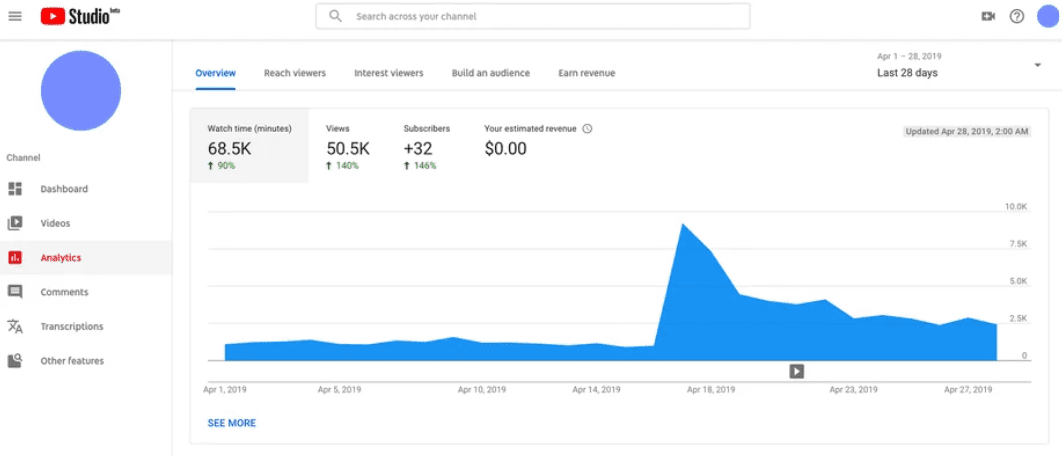
Step 2: Navigate to the Audience Tab
In the Analytics section, click on the “Audience” tab. This is where you’ll find data about your viewers, including:
- When your viewers are on YouTube
- Top geographies
- Age and gender demographics
- Returning vs. new viewers
Step 3: Understand the “When Your Viewers Are on YouTube” Graph
This is one of the most valuable tools available to creators.
You’ll see a 7-day heatmap broken down by hours. Each block is shaded from light to dark purple:
- Light purple = fewer viewers online
- Darker purple = higher concentration of viewers online
This heatmap shows not only when your subscribers are online but also all viewers who watch your videos, even if they’re not subscribed.
Key Takeaways From the Heatmap:
- Look for Consistent Peaks: If you notice high engagement around 5 p.m. to 8 p.m. from Tuesday through Friday, that’s a strong indicator of a good posting window.
- Identify Underperforming Periods: Time slots that consistently show low activity may not be ideal for posting new content.
- Track Over Several Weeks: Viewer patterns may change due to seasonality, trends, or audience growth. Check this graph periodically to stay aligned.
Step 4: Use Real-Time Data to Spot Trends
Alongside historical insights, YouTube also offers real-time analytics, which show activity over the last 48 hours.
This can help you:
- Detect how quickly a video picks up views after publishing
- Monitor spikes in engagement based on time of day
- Test different posting times and compare early performance
To access this, go to:
- YouTube Studio → Analytics → Overview tab → Realtime section
Check when your recent videos started gaining traction. If videos posted at 6 p.m. consistently see faster view counts than those posted at 11 a.m., that’s a valuable clue.
Step 5: Compare Performance Based on Publish Time
Use the “Content” tab in your YouTube Studio to analyze how past videos have performed based on posting time.
Here’s how to do it:
- Go to “Content”
- Click on a video you’ve already published
- Go to the “Analytics” section for that video
Note the publish time and compare:
- First 24-hour views
- Average view duration
- Click-through rate (CTR)
Repeat this across several videos to spot patterns. If most of your top-performing videos were published in the afternoon, for example, you may want to lock that into your schedule.
Step 6: Layer in Time Zone Insights
Your posting time should reflect your audience’s time zone, not just your own.
Under the Audience tab, scroll down to see Top Geographies. If most of your viewers are in:
- The U.S – prioritize Eastern and Pacific Time Zones
- The UK – optimize for GMT
- India – use IST (Indian Standard Time)
Adjust your publishing schedule accordingly. For instance, if your viewers are in New York (EST) but you’re in Berlin (CET), you may need to publish content late in your day to hit peak U.S. hours.
How Can You Check Analytics With Social Champ?
If YouTube Analytics doesn’t work for you, there’s another way to check how your content is performing on the platform.
Social Champ is an all-in-one solution to your social media hassles. You can schedule your YouTube videos months ahead with this tool.
And it also enables you to check analytics directly from its dashboard.
So no more switching to YouTube Analytics, just follow the guide below and become the master at using Social Champ!
“Social Champ provided an easy way to automate and deliver on our marketing needs! We love innovation, and features like using AI to determine the best time to post are exactly what we look for.” — Founder and CTO, Bare Cybersecurity

Optimize Every Post With Smart Analytics!
Discover what resonates with your audience and schedule future posts directly from your dashboard for better engagement.
Why Does Posting at the Right Time Matter for YouTube Growth?
Posting at the right time is essential because it’s how the YouTube algorithm decides to promote your content, affecting its long-term reach and success.
Why Are the First 48 Hours Critical for Algorithm Ranking?
The first 24 to 48 hours are highly important because YouTube’s algorithm essentially tests your video on a small audience, primarily your subscribers and frequent viewers.
- Signals to the Algorithm: A quick influx of high engagement (high Click-Through Rate or CTR, and strong Audience Retention) within this initial window signals to YouTube that the content is valuable and resonating.
- Wider Distribution: If the early metrics are positive, the algorithm is much more likely to push your video to a wider audience via the homepage, suggested videos, and search results. Conversely, a video that launches with little initial engagement may be “flatlined” or stop being heavily promoted, regardless of its quality.
- Maximizing Subscriber Activity: By posting when your target audience (especially your subscribers) is most active online, you increase the likelihood that they will see the video immediately, click it, and engage. This rapid burst of activity provides the crucial “test audience” data the algorithm needs to begin its broader distribution.
How Does Timing Affect Click-Through Rate (CTR) and Audience Retention?
- Improved CTR: When a video appears in your subscribers’ feeds at a time they are actively browsing, they are more likely to see and click on your thumbnail, which boosts your CTR. Posting during quiet hours means your video is often buried beneath newer content by the time they log on.
- Better Audience Retention: Posting when viewers are relaxed and have time to watch a video in its entirety (like evenings or weekends) can lead to higher audience retention and watch time. If a viewer clicks on your video but only has a moment to spare, they might watch for a few seconds and leave, hurting your retention rate.
What Role Does Audience Habit Play in Optimal Posting?
Your audience’s viewing habits are the single most important factor in determining your optimal posting time.
- Behavioral Alignment: Different niches and geographic audiences have different peak activity times. A channel focused on morning routines may do better early, while a gaming channel might thrive in the late afternoon/evening. The “best” time is unique to your channel.
- YouTube Analytics is Key: Use your YouTube Analytics (specifically the “When your viewers are on YouTube” report) to identify the purple-shaded blocks of time that indicate peak activity for your specific viewers. Posting just before or right at the start of these peak times ensures your video is at the top of their feed.
- Consistency Builds Expectation: Maintaining a consistent posting time (e.g., “Every Tuesday at 3 PM EST”) helps build a ritual for your viewers, encouraging them to look out for your new content and further boosting that initial engagement spike.
What Are the Worst Days and Timings to Post on YouTube?
The worst times to post on YouTube are typically those outside of peak viewer activity.
Generally, this includes early mornings, late nights, and certain weekend windows when viewers are less engaged.
Days and Times of Lowest Engagement
Based on general platform data, the days with the lowest overall engagement tend to be Sundays, followed closely by Mondays and Saturdays.
- Sundays often show the lowest engagement because many viewers are focused on offline activities, family time, or other media (like live sports).
- Mondays can be slow as viewers return to work or school routines and have less time for casual YouTube browsing.
- Saturdays can be inconsistent, with a slight dip in engagement as people are often out or active during the day.
The most critical window to avoid is often the early hours of the morning on any given day, as your audience is most likely asleep.
Here is a general summary of the timings often associated with the lowest engagement:
| Day of the Week | Worst Time Window to Post (General) | Notes on Low Activity |
|---|---|---|
| Monday | Before 12:00 PM (Noon) | Morning focus is on the start of the work/school week. |
| Tuesday | Before 11:00 AM | Low activity before the lunch break viewing window. |
| Wednesday | Before 11:00 AM | Activity is generally building, but mornings are slow. |
| Thursday | Before 10:00 AM | Low activity before the typical mid-day/afternoon surge. |
| Friday | After 8:00 PM | Engagement drops off sharply as the weekend begins. |
| Saturday | Before 12:00 PM (Noon) | Viewers are busy with morning activities and errands. |
| Sunday | Before 12:00 PM (Noon) & After 8:00 PM | On the day with the lowest overall engagement, viewers are typically offline or winding down early. |
Common Pitfalls to Avoid
Beyond the general timing, there are specific situations that guarantee low initial performance:
- Posting Too Early: Uploading a video at 1:00 AM to 6:00 AM ensures your video sits unseen at the top of the feed while your core audience sleeps. By the time they wake up, the video will have lost the crucial initial momentum.
- Holiday Posting: Avoid posting on major national holidays (e.g., Christmas, Thanksgiving, or local equivalent public holidays). Viewers are focused on family and celebrations, leading to an almost guaranteed drop in views and engagement.
- Posting During Live Events: If your audience follows a specific sport, awards show, or breaking news event, avoid posting during that time, as their attention will be elsewhere.
Conclusion
Today, knowing the best time to post on YouTube matters just as much as content quality.
As we’ve explored, posting between 3–5 PM on weekdays, especially on Wednesday, can significantly improve visibility and engagement.
Shorts follow a similar pattern, with Monday and Thursday also performing well.
We’ve also seen how understanding the best and worst days to post can help you avoid slow traffic periods and focus on high-impact windows.
Tools like Social Champ can streamline your scheduling process, ensuring your videos go live when your audience is most active.
Ultimately, using data to guide your timing gives you a strategic edge in an increasingly competitive platform.
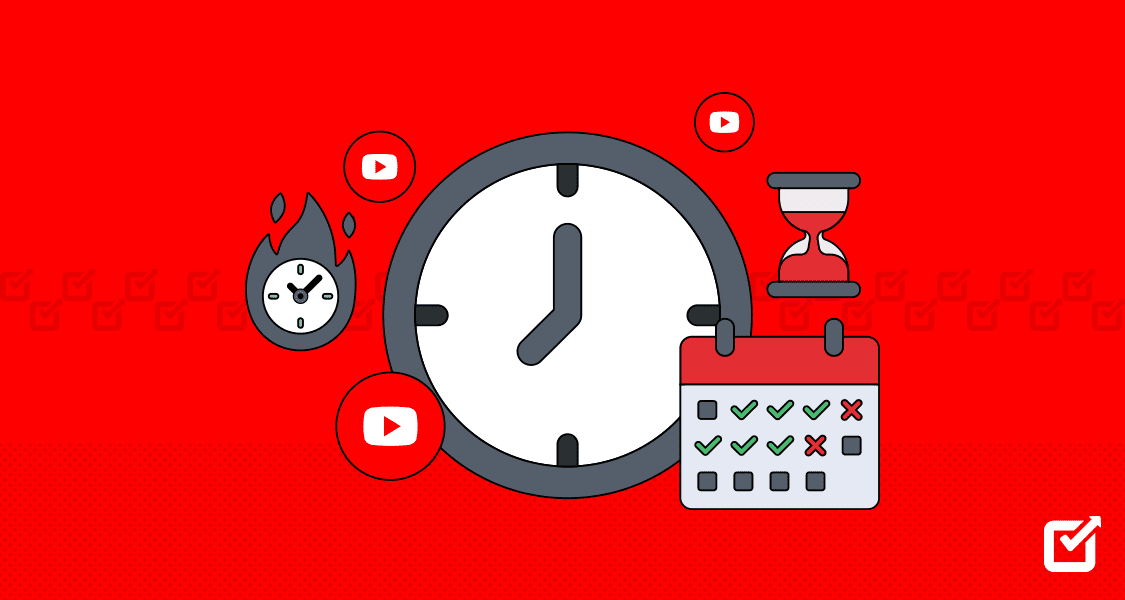


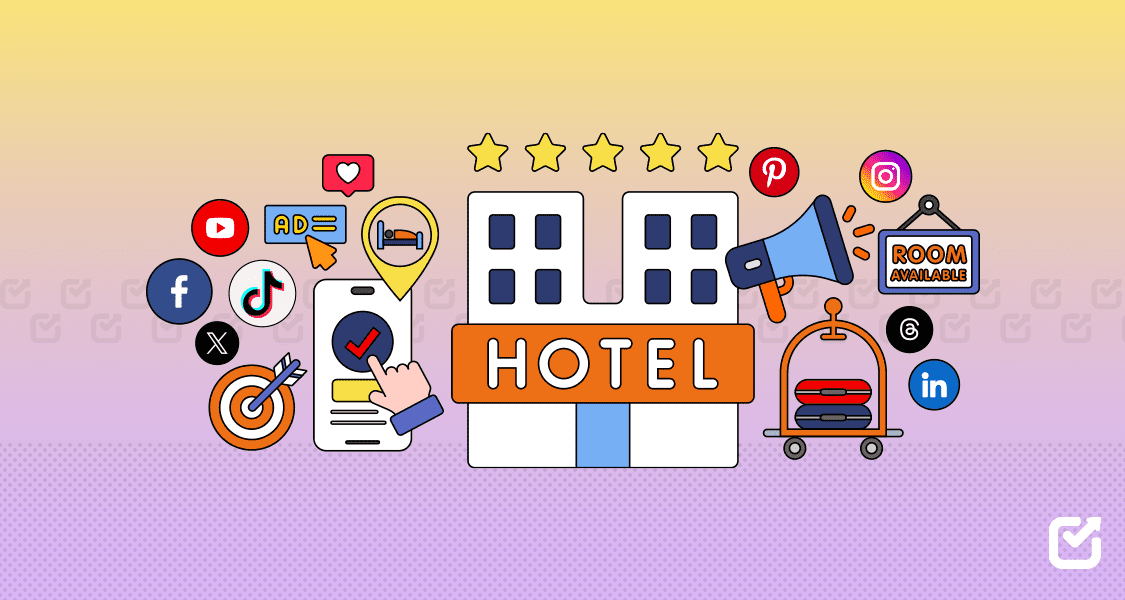
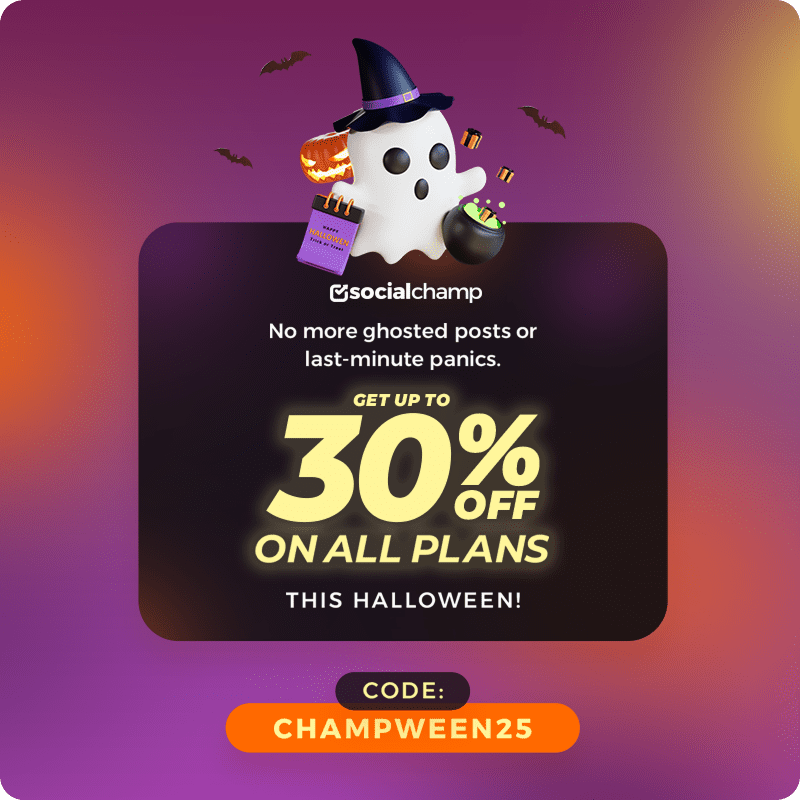
1 comment
Ben Jose
Yes, I too agree to the fact of the algorithm playing a major role behind the visibility of content at peak hours. Very well curated information.